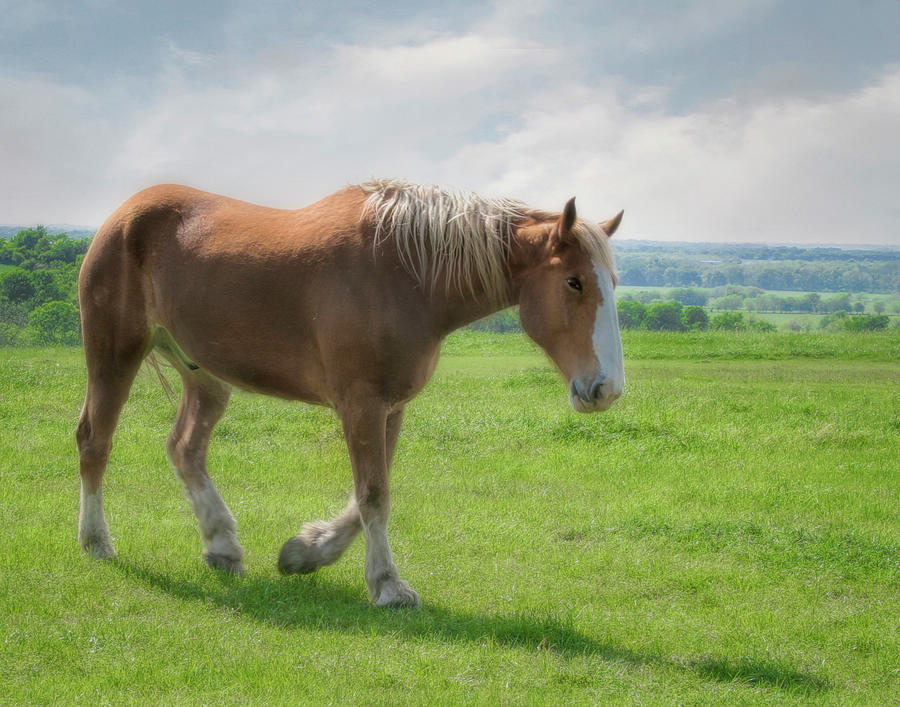

One of the lighter, more graceful draft horses, the Friesian is another Dutch breed. It displays heavy feathering about the legs. It is characterized by a docile temperament and good stamina. For a time, it was the most important Dutch breed of draft horse, but like many other breeds, it went into decline as farming became mechanized after the Second World War. The Dutch Draft is a large, stocky, muscular horse that was created in the early 20th century after the end of the First World War. However, this practice has put the survival of the breed at risk since many breeders concentrate on breeding sports horses while neglecting to allow mares to produce purebred horses and continue the line. This horse is often crossed with Thoroughbreds or warmbloods to produce a range of sports horses. It is a versatile workhorse with a docile temperament that stands at around 5.2-16.3 hands (158-170cm, 62-67in). The Irish Draught is the result of centuries of breeding, which included crossing the Irish Hobby with Anglo-Norman war horses, Iberian breeds, Clydesdales, Thoroughbreds and Connemara Ponies. Nowadays, they are a popular parade or carriage horse and are famously used by the Anheuser-Busch brewery in the United States for publicity purposes. The breed went into serious decline with the advent of mechanized farming and by the 1970s was in danger of extinction. They are usually bay in color with marked feathering around the legs, although other colors are possible. In the 19th century, Shire blood was also introduced to further enhance the breed.Ĭlydesdales are tall and powerful, standing at 16-18 hands (162-183cm, 63.5-72in), although they were shorter in the past. It is thought the breed originated when Flemish stallions were bred with local mares to increase their stature. The Clydesdale breed originates in Clydesdale, the old name for what is mostly now the county of Lanarkshire in Scotland. However, it is now relatively rare and is considered “critical” by the UK Rare Breeds Survival Trust. The Suffolk Punch was developed in the 16th century and is considered the oldest breed of draft horse in the world to still have the same recognizable form today. This breed also requires less feed than other similar types of horse, making it a more convenient, practical and economical animal to keep. It was bred for farm work and is considered to be hard-working and with a good temperament. It is always chestnut (traditionally spelled “chesnut”) in color. It is shorter and stockier than breeds like the Shire, usually measuring 16.2-17.2 hands (165-178cm, 56-70in).

The Suffolk Punch, also known as the “Suffolk Horse” is an English breed that originated in the county of Suffolk, hence the name. The largest horse ever recorded is thought to be a gelded Shire named Samson – whose name was later changed to Mammoth as he attained his famously gigantic proportions. Although this is now uncommon, a handful of breweries in the UK continue this practice, delivering beer by horse-drawn cart to this day. One of the traditional uses for Shire horses was to pull carts to deliver beer from breweries. However, Shire Horses have undergone a revival since the 1970s, and they remain a treasured part of English agricultural and rural culture. The breed went into decline as railways became more widespread and then especially with the advent of mechanized farming. It boasts exceptional pulling strength and was originally used for farm work and road haulage as well as for pulling barges at a time when England’s canal system formed an important part of the country’s transport infrastructure. The Shire, a breed of draft horse from England, is among the tallest, largest, heaviest and strongest breeds in the world, with stallions usually measuring around 17.2 hands (178cm, 70in) at the withers. However, many examples of these magnificent animals still exist, so here we look at 15 draft horse breeds that are either the most important or the most interesting. In the modern world, there is less need for working horses, and they are now far less common than in the past. Generally speaking, they are strong, intelligent, docile and willing to work, making them ideal animals for farm work as well as many other purposes. DIn pre-industrial times, draft horses were an important part of agricultural life in many countries around the world.


 0 kommentar(er)
0 kommentar(er)
